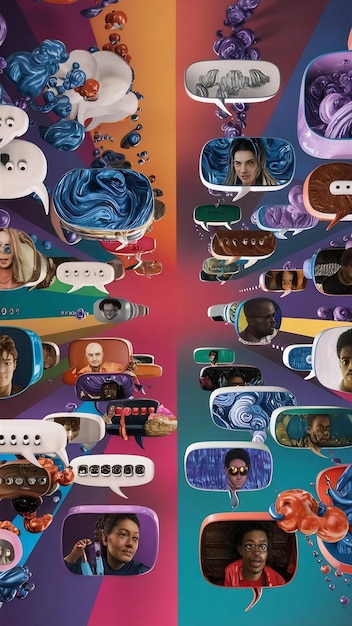The Invisible Challenge: Harmless Trend or Dangerous Obsession?

The ‘Invisible Challenge,’ a viral trend involving participants seemingly being tripped or pushed without physical contact, raises questions about its potential for harmless fun versus dangerous obsession due to the risk of injury and the spread of misinformation.
Is the ‘Invisible Challenge’ is Dominating Social Media: Is This Viral Trend Harmless Fun or a Dangerous Obsession? This new social media trend dividing opinions? Let’s delve into it.
What is the ‘Invisible Challenge’?
The ‘Invisible Challenge’ has recently surged in popularity across various social media platforms. But what exactly is it? And why is it capturing so much attention?
The Premise of the Challenge
At its core, the ‘Invisible Challenge’ involves two or more participants. One person stands still while others pretend to trip, push, or otherwise interact with them as if the stationary person is somehow physically affected.
How it’s Performed
Participants use creative acting and often exaggerate their movements to simulate an invisible force acting upon the central figure. The resulting videos are then shared on platforms like TikTok, Instagram, and YouTube.

The challenge gained traction due to its simplicity and the potential for humorous scenarios. However, concerns have arisen regarding its safety and overall impact.
The rise of the ‘Invisible Challenge’ is just one more example of how social media trends can go from being a joke to being harmful.
The Rise to Viral Fame
The journey of the ‘Invisible Challenge’ from a niche activity to a widespread phenomenon is a testament to the power of social media algorithms and the human desire for entertaining content.
Early Origins and Initial Spread
The exact origin of the ‘Invisible Challenge’ is difficult to pinpoint, but it likely emerged from smaller online communities focused on creative skits and practical joke simulations. Early videos may have showcased more elaborate setups and higher production values.
The Role of Social Media Algorithms
Platforms like TikTok and Instagram played a crucial role in catapulting the challenge to viral fame. Their algorithms, designed to maximize user engagement, prioritize content that is entertaining, easily replicable, and shareable. The ‘Invisible Challenge,’ with its short format, visual appeal, and humorous potential, fit perfectly into this mold.
- TikTok’s “For You” Page: The algorithm amplifies videos with high engagement rates, exposing them to a wider audience.
- Hashtags and Trends: Strategic use of trending hashtags increases discoverability.
- Duets and Remixes: The challenge encourages users to create their own versions, further spreading its reach.
Celebrity Influence and Mainstream Adoption
As the challenge gained momentum, it caught the attention of social media influencers and even celebrities. Their participation served as a major catalyst, introducing the challenge to a much broader audience and solidifying its place in the mainstream.
The rapid spread of the ‘Invisible Challenge’ is a reminder of the speed at which trends can evolve and gain prominence in the digital age.

Is it All Fun and Games? The Potential Dangers
While the ‘Invisible Challenge’ may appear to be a lighthearted and entertaining activity on the surface, it’s essential to consider the potential dangers that may lurk beneath the surface.
Risk of Physical Injuries
One of the most significant concerns surrounding the ‘Invisible Challenge’ is the risk of physical injuries. Participants attempting to simulate falls, pushes, or trips, could stumble unexpectedly resulting in physical harm to themself. These can range from minor scrapes and bruises to more severe injuries.
Spread of Misinformation
The videos lack of explicit caution or responsible practice may be seen by children and result in misinformation among those viewers.
The Psychological Impact on Victims
If the participant is not prepared to engage in the ‘Invisible Challenge’ or doesn’t feel comfortable doing so, they may experience feelings of anxiety, discomfort, or even fear.
Before participating in what appears to be a light-hearted exchange of fun, participants can consider the potential cost to their personal wellbeing.
Ethical Considerations
Beyond the immediate physical and psychological risks, the ‘Invisible Challenge’ raises important ethical considerations, particularly regarding consent, online behavior, and the potential for exploitation.
Consent and Social Pressure
The nature of the challenge can create uncomfortable situations where individuals feel pressured to participate, regardless of their comfort level. It’s crucial to ensure that all participants willingly consent to be involved and understand the potential risks.
Online Behavior and Bullying
The ‘Invisible Challenge’ can inadvertently facilitate bullying and harassment. If the challenge is used to single out, embarrass, or humiliate individuals, it crosses the line from harmless fun to harmful behavior.
- Cyberbullying: Using the challenge to target specific individuals with malicious intent.
- Social Exclusion: Excluding individuals from participating or ridiculing their attempts.
- Online Shaming: Sharing videos that portray individuals in a negative or demeaning light.
Exploitation and Objectification
In some cases, the ‘Invisible Challenge’ may involve elements of exploitation or objectification, particularly if it targets vulnerable individuals or promotes harmful stereotypes. It’s important to be mindful of the potential for the challenge to perpetuate harmful social norms.
The ethical implications of the ‘Invisible Challenge’ highlight the need for responsible online behavior and a critical understanding of the potential impact of social media trends.
Parental Guidance and Media Literacy
With the increasing prevalence of social media trends like the ‘Invisible Challenge,’ parental guidance and media literacy are more important than ever in safeguarding the well-being of young people. By providing children and teenagers with the tools and knowledge they need to navigate the digital landscape safely and responsibly, parents and educators can help them make informed decisions and avoid potential pitfalls.
Open Communication and Education
One of the most effective ways to address the potential risks associated with social media trends is to foster open communication and education. Creating a safe and supportive environment where children and teenagers feel comfortable discussing their online experiences can help them develop critical thinking skills and make informed decisions.
- Encourage dialogue: Initiate conversations about social media trends and their potential impact.
- Provide guidance: Offer advice and support on how to navigate online challenges and risks.
- Promote critical thinking: Encourage children and teenagers to question and evaluate the content they encounter online.
Setting Boundaries and Monitoring Usage
In addition to open communication and education, setting clear boundaries and monitoring social media usage can help protect children and teenagers from potential harm. By establishing guidelines for screen time, content access, and online interactions, parents can create a safer and more manageable digital environment.
Promoting Responsible Online Behavior
Ultimately, parental guidance and media literacy should aim to promote responsible online behavior and empower young people to become informed and ethical digital citizens. By teaching them how to engage with social media in a safe, respectful, and mindful manner, parents and educators can help them harness the positive aspects of the digital world while minimizing the potential risks.
Emphasizing the importance of caution and consideration, parents can do much in teaching their children to navigate the viral trends of modern media.
The Future of Viral Challenges
The ‘Invisible Challenge’ is just one example of the ever-evolving landscape of viral challenges. As social media platforms continue to evolve and new technologies emerge, it’s likely that we’ll see even more innovative and potentially risky trends emerge in the future.
Innovation in Future Challenges
Future challenges may incorporate new technologies such as augmented reality (AR), virtual reality (VR), and artificial intelligence (AI). These technologies could create even more immersive and engaging experiences, blurring the lines between the physical and digital worlds.
The Trend Cycle: From Fad to Forgotten
Like all trends, the ‘Invisible Challenge’ will eventually fade from popularity. The shelf life of viral sensations is often short, as users move on to the next exciting or humorous phenomenon.
The cycle of trending challenges teaches us that it is important to stay critical about the trends we see and to always consider the potential danger in the pursuit of viral fame.
| Key Point | Brief Description |
|---|---|
| 🤔 Challenge Premise | Simulates invisible interaction with a standing person. |
| ⚠️ Potential Dangers | Risk of injuries during simulated falls and pushes. |
| ✅ Ethical Concerns | Consent, social pressure, online behavior considerations. |
| 🛡️ Parental Guidance | Open communication, boundaries, and responsible behavior are crucial. |
FAQ
▼
The ‘Invisible Challenge’ involves participants pretending to interact with someone as if they’re tripping or pushing them, while the standing person acts as if they’re affected by an invisible force.
▼
The primary concerns include the risk of physical injuries from simulated falls and pushes, as well as the potential for ethical issues related to consent and online bullying.
▼
Parents can promote open communication about social media trends, set clear boundaries for online usage, and encourage responsible online behavior to keep their children safe.
▼
Challenges can eventually incorporate more advanced tech to enhance participant experiences. However, like anything on the internet, challenges such as the ‘Invisible Challenge’ are almost always temporary.
▼
The ‘Invisible Challenge’ should serve as a cautionary tale that highlights the importance of caution in participating with trends seen online. As always, if at any time participants feel uncomfortable, they may want to avoid participation.
Conclusion
In conclusion, the ‘Invisible Challenge’ is a powerful reminder of the potential impact of social media trends on individuals and society. While it may seem like harmless fun on the surface, it’s crucial to be aware of the potential dangers and ethical considerations that may arise. By promoting critical thinking, responsible online behavior, and open communication, we can harness the positive aspects of social media while minimizing the risks.